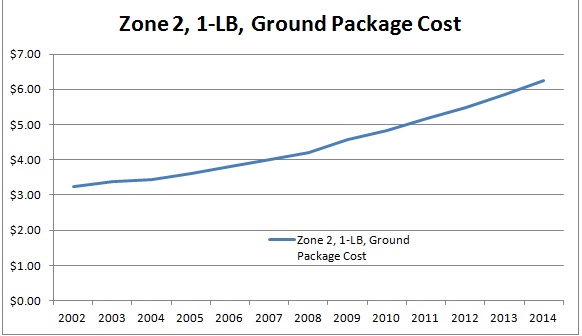As the second quarter of 2014 continues, your finance department should be looking at your increasing transportation costs and reviewing how much your company was affected by the annual rate increase put in place by your shipping carriers for the year. While the carriers state in their press releases that prices are going up by an “average” amount, you should be aware of how the average is calculated by the carriers and how it may not be affecting you by an average amount.
In late 2013, the US parcel carriers made their annual announcements that due to the increasing cost of doing business, an increase in their base pricing would be made that affects all of their customers. For both carriers, it was stated that the 2014 pricing for Ground shipments would increase by “an average net 4.9%." UPS’s Express/Air shipment prices increased by an average of 4.9%; FedEx Express increased by 3.9%.
But what does that average mean?
There is a carrier rate chart published for each service level, showing the price that applies for each combination of weight (every 1-lb increment) and zone. The zone is a grouping by distance that will need to be travelled, typically from Zone 2 at the shortest distances to zone 8 moving cross-country. Each year, the carriers will update every price on that chart, and take the average increase across all of the individual increases in order to determine the average increase for that service. They will then average up all of the increases for Ground services and call that the total average Ground yearly increase, and the same for Express and
International services.
How do these individual prince increases affect the average?
The carriers typically increase the shorter-distance, lower-weight prices by a larger margin than the higher-weight, longer-distance shipments. This allows the average to balance out for the service, while increasing the carriers' ROI for the less cost-effective shipments they will be making over the course of the year.
As an example, the lowest-cost shipment available is typically a Zone-2 (shortest distance), one-pound Ground shipment. In 2013, this price for both carriers was $5.84. Both carriers increased this price in 2014 to $6.24 – an increase of about 6.8%, which is far higher than the average stated increase of 4.9% for the service as a whole.
A similar comparison for an Express service shows the lowest-weight shipments increasing by about 7.5%, again higher than the average and balanced out by lower-increased pricing for heavier shipments.
This means that a company that primarily ships smaller-weight shipments (under 10 pounds on average) will experience an increase in cost that is higher than the national average increase, whereas a company shipping exclusively packages weighing over 20 pounds will be much less affected by the annual increase.
What can I do to help my business avoid this skewed increase?
One thing that you can do is to work with your carrier to adjust or amend your current agreement to put a cap on your yearly increases in pricing. By being a valued customer and shipping a guaranteed amount of volume with the carrier, you should be able to come to an agreement regarding a cap on your increases each year that is below this national average. This will help offset some of your increases and minimize the overall effect of the yearly General Rate Increase.
Is this a recent trend that will eventually go away?
For over a decade, the US parcel carriers have been increasing prices, and it does not look to be a trend that will be stopping anytime soon. For an example of how the Ground Minimum price (for a Zone 2, 1-lb package) has increased over the past few years, you can refer to the chart below.
In late 2013, the US parcel carriers made their annual announcements that due to the increasing cost of doing business, an increase in their base pricing would be made that affects all of their customers. For both carriers, it was stated that the 2014 pricing for Ground shipments would increase by “an average net 4.9%." UPS’s Express/Air shipment prices increased by an average of 4.9%; FedEx Express increased by 3.9%.
But what does that average mean?
There is a carrier rate chart published for each service level, showing the price that applies for each combination of weight (every 1-lb increment) and zone. The zone is a grouping by distance that will need to be travelled, typically from Zone 2 at the shortest distances to zone 8 moving cross-country. Each year, the carriers will update every price on that chart, and take the average increase across all of the individual increases in order to determine the average increase for that service. They will then average up all of the increases for Ground services and call that the total average Ground yearly increase, and the same for Express and
International services.
How do these individual prince increases affect the average?
The carriers typically increase the shorter-distance, lower-weight prices by a larger margin than the higher-weight, longer-distance shipments. This allows the average to balance out for the service, while increasing the carriers' ROI for the less cost-effective shipments they will be making over the course of the year.
As an example, the lowest-cost shipment available is typically a Zone-2 (shortest distance), one-pound Ground shipment. In 2013, this price for both carriers was $5.84. Both carriers increased this price in 2014 to $6.24 – an increase of about 6.8%, which is far higher than the average stated increase of 4.9% for the service as a whole.
A similar comparison for an Express service shows the lowest-weight shipments increasing by about 7.5%, again higher than the average and balanced out by lower-increased pricing for heavier shipments.
This means that a company that primarily ships smaller-weight shipments (under 10 pounds on average) will experience an increase in cost that is higher than the national average increase, whereas a company shipping exclusively packages weighing over 20 pounds will be much less affected by the annual increase.
What can I do to help my business avoid this skewed increase?
One thing that you can do is to work with your carrier to adjust or amend your current agreement to put a cap on your yearly increases in pricing. By being a valued customer and shipping a guaranteed amount of volume with the carrier, you should be able to come to an agreement regarding a cap on your increases each year that is below this national average. This will help offset some of your increases and minimize the overall effect of the yearly General Rate Increase.
Is this a recent trend that will eventually go away?
For over a decade, the US parcel carriers have been increasing prices, and it does not look to be a trend that will be stopping anytime soon. For an example of how the Ground Minimum price (for a Zone 2, 1-lb package) has increased over the past few years, you can refer to the chart below.

By paying close attention to the way that the carriers perform their annual rate increases and how it affects your shipping, you will be in a better position to know how to negotiate a capped increase and prepare for future transportation cost increases.
Aaron Samuels is Managing Partner at BridgeNet Solutions. Visit www.bridgenetsolutions.com for more information.
Aaron Samuels is Managing Partner at BridgeNet Solutions. Visit www.bridgenetsolutions.com for more information.




